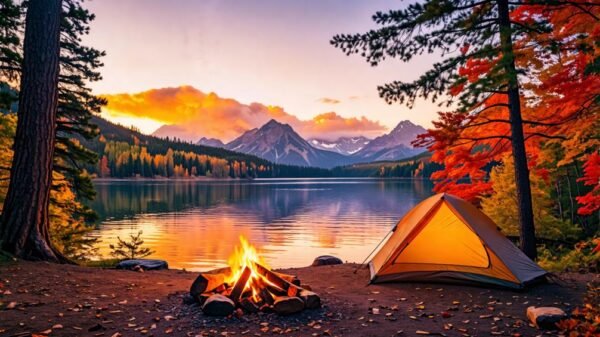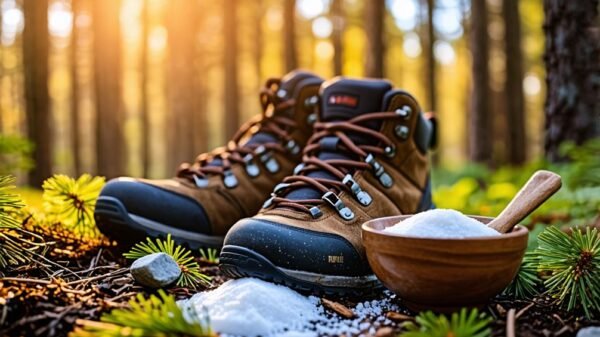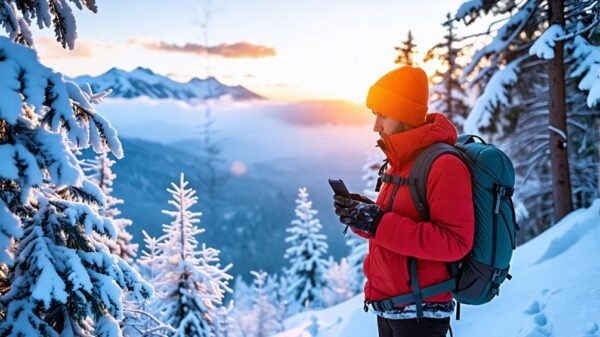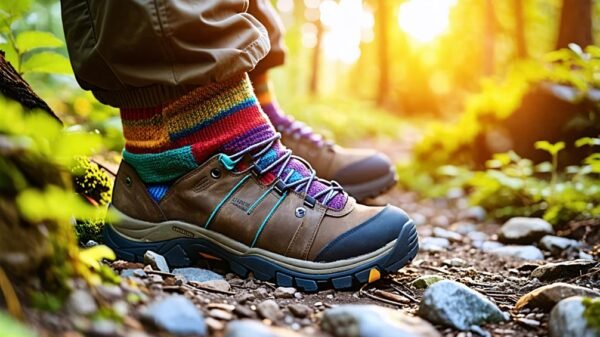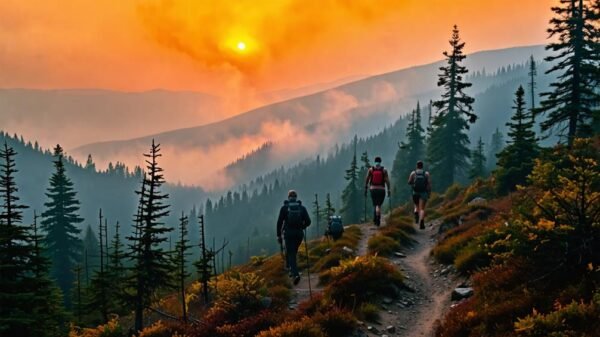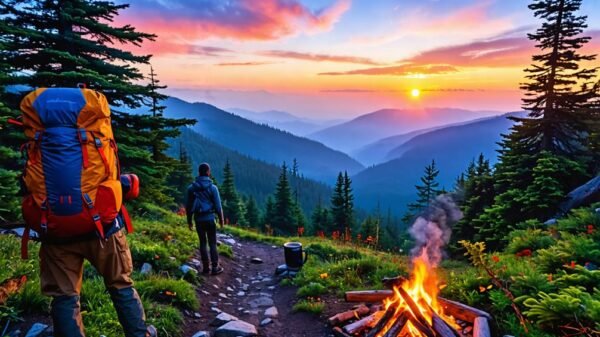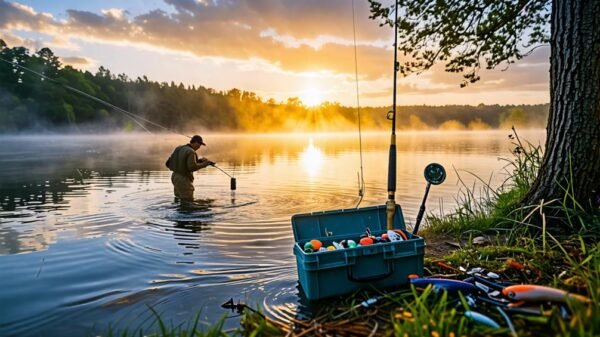Solo backpacking offers a fulfilling experience but requires thoughtful preparation. Choose a destination that matches your interests and abilities. Learn fundamental navigation skills, such as using a map and compass, to keep yourself safe. Prioritize hygiene by using eco-friendly products and setting up camp responsibly, away from water sources. Be mindful of wildlife behaviors, especially in bear-prone areas, and know how to react to encounters. Pack a well-fitted backpack with necessary gear, including essential aid supplies and water filters. By following these guidelines, you can enjoy nature responsibly while minimizing your impact. More insights await to enrich your adventure.
Essential Preparation Tips
Effective independent backpacking begins with meticulous preparation, ensuring that every facet of the journey is well-organized for enhanced safety and enjoyment. The first task involves selecting a destination that matches your interests and skill level, allowing for a deeper engagement in outdoor solo travel. Investigate popular hiking trails, such as those in the Appalachian Mountains or the Pacific Crest Trail, and read reviews to discover well-frequented routes that can boost your sense of security while trekking alone.
Next, determine the best time for your adventure by considering weather trends and personal schedules. Developing a comprehensive itinerary is essential; this plan should outline daily activities and include backup options to handle unforeseen circumstances. Packing high-quality gear, such as a North Face backpack or MSR stove, is another critical component of preparation. Invest in reliable equipment that seasoned backpackers recommend to ensure performance on the trail.
Safety and Navigation Skills
Mastering safety and navigation skills is essential for solo trekkers, as they ensure protection and enable confident traversal of uncharted landscapes. Proper preparation allows for an enjoyable adventure with peace of mind. Here are key backpacking tips to enhance your safety:
- Acquire fundamental wilderness survival techniques, including shelter construction and fire ignition.
- Communicate your travel plans to a reliable friend or family member for additional security.
- Become proficient in reading topographic maps, using Garmin GPS devices, and navigating with compasses.
Hygiene Practices and Campsite Selection

Maintaining cleanliness and selecting suitable campsites are essential for a successful solo backpacking adventure, ensuring personal health and environmental protection. To uphold hygiene, utilize reusable and biodegradable products, such as Eco-Products, which help reduce waste. Always wash hands with Dr. Bronner's biodegradable soap before meals or after restroom use. Carry a small trowel, like the Black Diamond Mini Trowel, for digging a 'cathole' at least six inches deep, away from water sources, to dispose of human waste responsibly.
When selecting a campsite, search for flat, dry ground that is a minimum of 200 feet from lakes and rivers. This distance safeguards water sources from contamination. Look for natural windbreaks, such as trees or rocks, to protect your camp from severe weather. Inspect for hazards like dead branches overhead, often referred to as widowmakers, which could fall unexpectedly. Additionally, always adhere to local camping regulations and guidelines to ensure a safe and enjoyable experience.
Wildlife Encounters Management
Navigating wildlife encounters is vital for personal safety and the preservation of natural environments during solo hiking adventures. As you explore scenic landscapes, being prepared for interactions with animals enhances your journey, allowing for a respectful connection with the wilderness.
- Experience the thrill of spotting a graceful elk in its natural surroundings.
- Marvel at the sight of an eagle gliding across the sky, unbothered by human presence.
- Find peace in your ability to manage wildlife interactions safely.
To handle wildlife encounters wisely, maintain a respectful distance from creatures, and avoid approaching them. Familiarize yourself with regional fauna and their behaviors, including bear safety guidelines, which involve utilizing BearVault containers for food storage and carrying bear deterrent spray. Remain calm during wildlife interactions and trust your instincts—if a situation seems threatening, retreat gradually. By adhering to these practices, you protect yourself and demonstrate respect for wildlife, ensuring these extraordinary beings remain unharmed. Remember, being a conscientious hiker enables you to relish the beauty of nature while actively contributing to its preservation.
Recommended Packing Gear
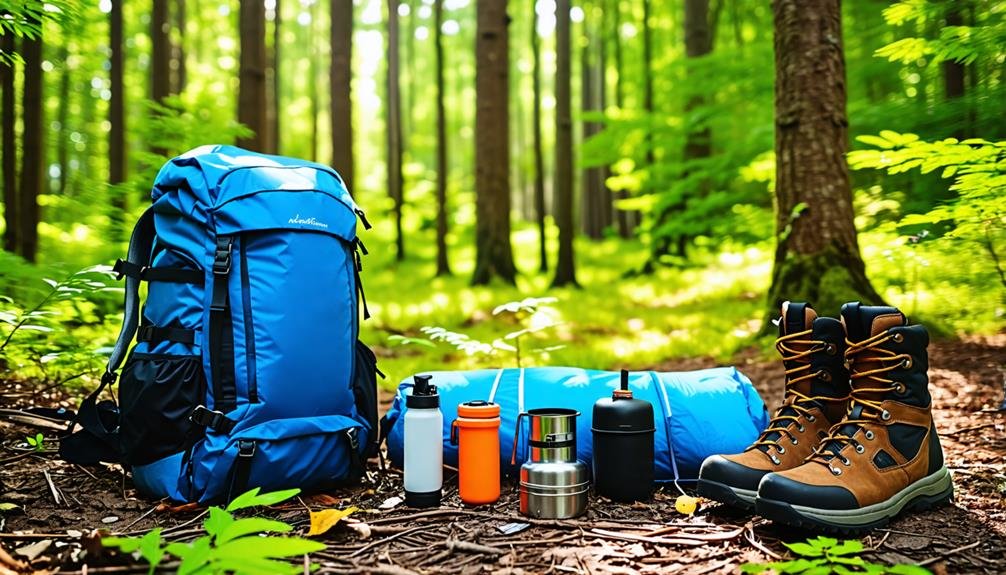
Selecting the ideal packing gear is crucial for a successful solo backpacking adventure. Focus on a well-fitted Osprey backpack that distributes weight evenly, ensuring comfort during long hikes. A lightweight, durable REI tent or ENO hammock offers shelter without excessive bulk. Choose a sleeping bag, like the Marmot Superalloy, rated for the temperatures you might face, guaranteeing warmth and comfort on chilly nights.
Include a reliable Sawyer water filtration system to provide clean drinking water, essential for staying hydrated on the trail. A compact Adventure Medical Kits first aid kit is important for tending to minor injuries, while a Jetboil stove allows you to prepare warm meals, enhancing your wilderness experience.
Pack essential clothing items, including moisture-wicking layers, a Columbia waterproof jacket, and sturdy Merrell hiking boots suitable for various terrains. A Leatherman multi-tool or knife can be invaluable for various tasks along the journey. Lastly, carry a National Geographic map and compass or a Garmin GPS device for navigation, ensuring you stay oriented in your explorations. With the right equipment, you can embrace the freedom of solo backpacking, confident that you're ready for whatever nature has in store.
Meal Planning and Nutrition
Efficient meal planning and nutrition are essential for a successful solo backpacking trip, providing sustained energy and promoting overall health during your journey. Proper nutrition fuels your body and enhances your experience in nature. When planning your meals, focus on lightweight, nutrient-rich options that are easy to prepare and transport.
- Enjoy the rich flavor of Quaker Oats for a filling breakfast as you witness the dawn.
- Relish a comforting bowl of Campbell's soup after a challenging day on the trail.
- Snack freely on Nature Valley trail mix, filled with nuts and dried fruits for a quick energy boost.
Aim for a balanced diet that includes carbohydrates, proteins, and fats. For example, Mission whole-grain wraps can hold various fillings, while Mountain House dehydrated meals offer convenience for cooking on-the-go. Stay hydrated by carrying sufficient water or using a reliable purification method like the Sawyer Mini. By carefully planning your meals, you enhance your adventure, embrace the independence of solo backpacking, and ensure your body is energized for the trails ahead.
Eco-Friendly Backpacking Practices
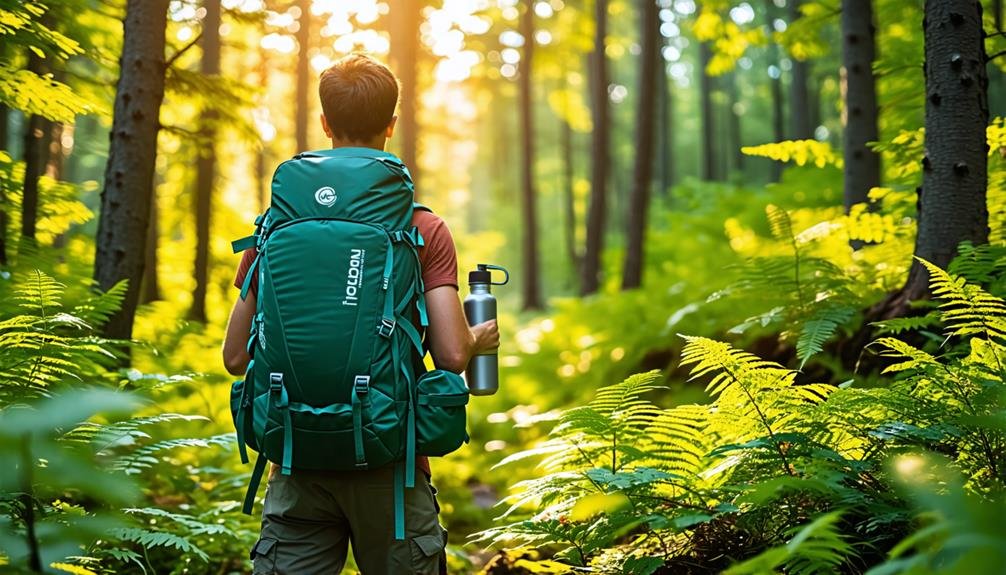
Engaging in eco-friendly backpacking practices is crucial for preserving natural environments while enjoying the great outdoors. Selecting sustainable gear, implementing waste reduction strategies, and adhering to Leave No Trace principles are key steps every solo backpacker can take. By being mindful of our impact, we contribute to the protection of wilderness areas, ensuring they remain beautiful and accessible for future adventurers.
Sustainable Gear Selection
Selecting sustainable gear is essential for eco-friendly hiking practices because it reduces ecological impact while improving the overall outdoor adventure. When choosing your equipment, focus on items made from recycled materials, such as Patagonia's recycled jackets, which help minimize waste and resource use. Opt for durable gear, like MSR tents, that has longevity, saving money and reducing the need for replacements.
Here are some important eco-friendly gear selection recommendations:
- Pick a Osprey backpack made from recycled textiles, supporting a circular economy.
- Choose a Big Agnes tent constructed with environmentally friendly materials, ensuring a smaller ecological footprint.
- Invest in a Katadyn water filtration system to eliminate the need for single-use plastic bottles.
Waste Reduction Strategies
Implementing effective waste reduction strategies is essential for preserving natural ecosystems while enjoying the advantages of hiking. One simple method to decrease waste is by using reusable products, such as Nalgene water bottles, stainless steel utensils, and silicone food containers. This practice not only reduces litter but also encourages a more sustainable approach during your outdoor excursions.
Consider using Dr. Bronner's biodegradable soap for dishwashing, which ensures that your campsite remains clean and safe for wildlife. Additionally, choose lightweight, dehydrated meals from brands like Mountain House that have minimal packaging, or prepare your own meals at home to control waste.
Another practical approach is to plan your meals carefully to prevent food waste. Pre-portion snacks in resealable bags to maintain portion control. Always carry a small trash bag, like a Ziploc, to collect any waste, whether it's your own or litter encountered on the trail.
Leave No Trace Principles
Respecting Leave No Trace principles is essential for safeguarding the beauty of natural landscapes while enjoying outdoor adventures. These guidelines assist in reducing our environmental impact and ensuring that the splendor we appreciate is preserved for future explorers. By embracing these principles, we can connect with nature while feeling a profound sense of duty.
- Capture only memories; leave only footprints.
- Safeguard the wildlife inhabiting these areas.
- Allow future generations to witness the same splendor.
To implement these principles, always carry out what you bring, including refuse and leftover food. Stick to marked paths to prevent soil degradation and protect fragile ecosystems. Camp at least 200 feet away from freshwater sources to keep them pristine. Additionally, opt for biodegradable products for personal care and cooking to further minimize your ecological footprint.



